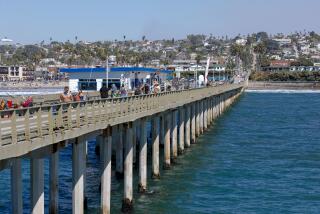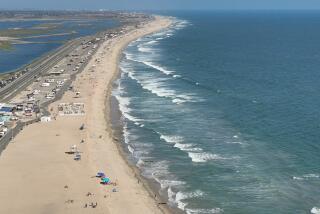A High Tide of Civic Pride Surrounds Rebuilt Pier : Landmark: Huntington Beach will hold a two-day celebration to mark the opening. The new, $10.8-million structure is built to withstand stormy weather.
HUNTINGTON BEACH â Like a phoenix, a gleaming new pier has risen from the sea in the spot where its venerable predecessor stood for 76 years.
The off-white, $10.8-million landmark was built despite a persistent recession and the whims of waves and weather. Now the basic structure is finished; itâs all over except for the shouting.
And the shouting begins next weekend. With a mixture of pomp and populism, this doughty old seaside community will open its new walkway to the sea with a two-day celebration that starts at 10 a.m. Saturday.
âThe whole city is excited about this,â Mayor Jim Silva said. âThis is a state-of-the-art new pier. Itâs a very historical event for the city.â
Work on the pier has been underway for the past 20 months, fascinating residents and visitors.
At the busy intersection of Pacific Coast Highway and Main Street, people daily have watched the spectacle of a behemoth arising from the beach and sea--a landmark in the making. The loud, rhythmic pounding of the giant hammer, driving pilings into the seaâs sandy bottom, for many months seemed a work anthem in downtown Huntington Beach.
âI watched the new pier as it was being built day by day,â said Harvey Klein, manager of Maxwellâs Restaurant, which adjoins the pier. âThe construction is totally different for something like this. They were replicating the old pier, but putting more strength and stability into the new pier, making it stronger and better. It was great to watch. And now itâs good to see the pier opening again; itâs like an old friend coming home.â
The pier was designed by Moffat & Nichol Engineers of Long Beach. James Crumpley, project manager for the firm, said they tried to re-create the feel of the old pier while introducing some new twists.
The end of the new pier is 13 feet higher off the water than the old pier and is diamond-shaped, rather than square like the old pier. The diamond shape helps deflect wave action and makes the pier end less vulnerable to storm damage. The added height above the ocean similarly protects the pier terminus, Crumpley said.
As part of the design to make the ocean end higher than the entrance, the new pier slopes gently upward as it goes out to sea. The old pier, in contrast, was built with no deliberate slope design, although it nonetheless dipped curiously at the end.
City Engineer Bob Eichblatt said that the old pierâs ocean end was lower than the rest of the structure because of cost-cutting repairs many years ago. The city, in rebuilding the end of the pier several decades ago, bought off-the-shelf pilings that were priced right but simply too small, Eichblatt said.
âThe end of the new pier is stronger by being higher above the water,â Eichblatt said.
Another new feature of the pier is slanted pilings interspersed among the vertical pilings. These slanted concrete pillars are called âbatter pilingsâ and were driven into the ocean floor at angles that give greater strength to the pier. There is a total of 312 pilings under the pier, including 72 batter pilings.
Construction of the pier was remarkably smooth and problem-free, city officials said. The structure is opening about four months later than planned, but officials said that such a delay is negligible, considering the size and scope of the project.
In 1990, the city sought bids for construction of the new pier. City officials expected the low bid to be $11.2 million or higher for construction of the basic pier, not including any pier buildings.
To the cityâs delight, however, Riedel International of Portland, Ore., said it could build the pier for $8.6 million.
âIt was clearly a real bargain for the city,â City Administrator Michael T. Uberuaga said.
As had been expected by city officials, other expenses of building a new pier, including planning and design, raised the total cost for the basic structure to $10.8 million. The final cost stayed within budget, but the city, mainly because of the recession, was not able to raise all of the money. The city is still short about $1.5 million of the $10.8-million cost, Deputy City Administrator Robert Franz said last week.
Franz said the $1.5-million shortfall is being covered by borrowing from the cityâs water fund.
The City Council still has not decided on how to finance three commercial buildings scheduled for the pier. The city plans to build a Rubyâs cafe at pierâs end, a snack shop and a combination snack and bait shop. The three commercial buildings are expected to cost $1 million. Uberuaga said the city plans to have the new structures built by the summer of 1993.
A financial analysis showed that the city would get more income from the cafe and snack shops if the city, rather than restaurant operators, built them.
But the cityâs planning for the buildings has lagged behind construction of the pier itself.
When the pier opens on Saturday, only temporary buildings will be on the new structure: the lifeguard tower salvaged from the old pier and a temporary restroom. A new, permanent lifeguard tower and new restroom complex are scheduled to be built on the new pier by next summer. They are expected to cost $300,000, and the City Council in February funded them by extending a surcharge on beach parking.
Raising money for the pier has been tough, city officials noted, because of the prolonged recession. Nonetheless, the project has enjoyed strong public support.
Uberuaga noted that in addition to big corporate donors, many rank-and-file residents of all ages, incomes and occupations gave money to help build the new pier.
âPeople gave money, such as $5 contributions, because they supported the new pier,â Uberuaga said. âThere was a broad cross-section of support, and it continued even though the economy got bad. I think it was very unusual.
âIt was unusual because you just donât find many public building projects receiving support like this one did.â
Rebirth of a Pier
Four years ago, the venerable but crumbling Huntington Beach Pier was closed and later destroyed. A new pier has risen in its place, one meant to last well into the next century.
New and Improved
Huge, storm-driven waves twice wiped out the old pierâs low-slung, boxy ocean end. The new pierâs end is 13 feet higher and diamond-shaped to deflect waves.
Snack shop (not yet built)
Lifeguard tower (temporary)
Restrooms (temporary)
Snack Shop / Bait and tackle (not yet built)
Restaurant (not yet built)
Building Over The Water
1) A diesel-powered pile driver was used to hammer concrete pilings, some as long as 131 feet, into the sea floor.
2) Once a row of three piles had been driven, their concrete tops were chipped away to expose steel reinforcing rods buried inside.
3) The exposed rods were bent and tied into other reinforcing rods, which were placed across the entire row, linking the piles together.
4) Concrete deck sections were nestled between rows of pilings. Reinforcing rods sticking out of each section were meshed with the rods atop the piles.
5) More reinforcing steel was added along the sides of each deck section.
6) Concrete was poured to fill gaps and cover the steel reinforcing rods. Wooden molds held the wet concrete until it hardened.
Drilling with Water: High-pressure water pumped through a tube in pilings pushed sand aside, allowing the 30-ton piles to drop under their own weight. Some sank 60 feet deep.
Strength of Steel: Reinforcing steel embedded inside of concrete strengthens and allows pieces of the pier to be wired together.
Vital Statistics Cost: $10.8 million (without buildings) Total pilings: 312 Lighting: 54 poles Deck space: 74,000 square feet (room to park about 600 average cars) Height: 38 feet high at ocean end, from the deck to low-tide mark Length: 1,856 feet; 36 feet longer than old pier Longest O.C. pier: 1,865 feet, in Seal Beach Worldâs longest pier: 7,075 feet (1.3 miles), in Southend-on-Sea, England Source: Huntington Beach City Engineer Robert Eichblatt; Willamette-Western Corp.; Guinness Book of World Records
Researched by DANNY SULLIVAN and BILL BILLITER / Los Angeles Times
A Landmarkâs Fall and Rise
The old Huntington Beach pier, built in 1914, fell victim to old age and stormy weather.
In 1983, a fierce winter storm ripped off the end of the pier and the cafe situated there. The city rebuilt the end of the aged structure in 1985, only to see it ripped away again by huge waves in 1988.
After the â88 storms passed, engineers found the pier was too far gone to be restored again. Safety officials insisted on closing the pier that summer.
The city went into mourning.
âHuntington Beach without its pier is like Paris without its Eiffel Tower,â said then-Mayor John Erskine.
Now, four years later, the city is on the threshold of opening its new landmark. As one city official put it, the upcoming celebration âis not merely a reopening, but will more resemble a homecoming or a family reunion.â
Highlights of Pier Festival
Huntington Beach is offering an array of free events on Saturday and July 19 from 10 a.m. to 6 p.m. to celebrate the opening of its new pier. Most events are at the pier at Main Street and Pacific Coast Highway.
Here are some highlights:
SATURDAY
10 a.m. Ribbon cutting
11 a.m.: Classic Car Parade
Noon: Dory races
2 p.m.: Rock and Dixieland music
6 p.m.: Rock and cloggers
SUNDAY, JULY 19
10 a.m.: Classic rock music
Noon: Country Gospel Jubilee
1 p.m.: Blues music
3 p.m.: Drama: âA Teenagerâ
5 p.m. Western band
More to Read
Sign up for Essential California
The most important California stories and recommendations in your inbox every morning.
You may occasionally receive promotional content from the Los Angeles Times.










